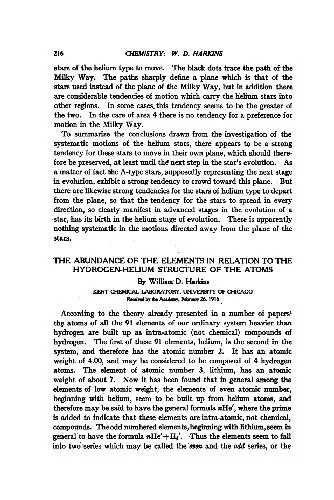The Abundance of the Elements in Relation to the Hydrogen-Helium Structure of the Atoms
4.7
Reviews from our users

You Can Ask your questions from this book's AI after Login
Each download or ask from book AI costs 2 points. To earn more free points, please visit the Points Guide Page and complete some valuable actions.Introduction to "The Abundance of the Elements in Relation to the Hydrogen-Helium Structure of the Atoms"
Welcome to the detailed introduction of the groundbreaking scientific work, "The Abundance of the Elements in Relation to the Hydrogen-Helium Structure of the Atoms". This book by Harkins W. D. discusses one of the most fundamental questions in science: the nature, distribution, and abundance of elements in the universe, and their intricate relationship with the atomic structure dominated by hydrogen and helium. By offering profound insights into the building blocks of matter, this work lays the foundation for modern atomic theory and cosmology.
In this book, the primary focus is placed on the significance of hydrogen and helium as the cornerstone of the universe’s composition. Chiefly, it presents the pivotal idea that these two elements, due to their simplicity and prevalence, hold the answers to some of the most pressing questions in chemistry, astrophysics, and nuclear science. Through well-constructed arguments and insightful observations, the book illustrates how nature's simplicity ultimately leads to a magnificent complexity, shaping the stars, planets, and life itself. The themes and findings in this book have acted as a cornerstone for many scientific advancements of the 20th and 21st centuries.
Detailed Summary of the Book
The book begins by laying out the fundamental principles of atomic structures, with a special focus on hydrogen and helium—the most abundant elements in the universe. It explains how the early universe's formation concentrated these elements and how their interaction gave rise to other heavier elements through stellar nucleosynthesis.
The unique properties of hydrogen and helium are explored in detail, discussing their atomic weights, isotopic variations, and roles as precursors to all other elements in the periodic table. The narrative further ventures into the correlation between atomic abundance and cosmic phenomena, bridging theories of atomic behavior with celestial observations.
In subsequent chapters, the author introduces evidence supporting the hydrogen-helium atomic framework, including calculations of their respective proportions in stars, planetary atmospheres, and galaxies. The book concludes by addressing the implications of this model for understanding elemental formation, stellar evolution, and the origin of natural elements as we know them on Earth and beyond.
This rigorous analysis not only deepens our understanding of atomic structures and their behavior but also serves as a testament to how scientific investigations can inspire inquiries that transcend disciplinary boundaries.
Key Takeaways
- The universe is predominantly composed of hydrogen and helium, which account for the bulk of all matter.
- Hydrogen and helium form the basis of the atomic structure, serving as the foundation for the creation of all heavier elements through nuclear fusion within stars.
- The study of elemental abundance has significant implications for astrophysics, chemistry, and the study of Earth’s geology.
- Understanding atomic structure through hydrogen-helium dynamics is pivotal to unraveling the mysteries of the universe's formation and evolution.
Famous Quotes from the Book
"Nature, in its inherent simplicity, has bestowed upon hydrogen and helium the privilege of being the foundational architects of the universe."
"The abundance of elements is not merely a matter of numbers—it is the story of the cosmos itself, written in the language of atoms."
Why This Book Matters
This book is not just another scientific treatise; it is a pioneering exploration of the principles that govern our understanding of the universe. It bridges chemistry, physics, and astrophysics to provide a cohesive explanation of how the universe’s most abundant elements play a critical role in shaping the cosmos.
By answering fundamental questions about the origins and distribution of elements, "The Abundance of the Elements in Relation to the Hydrogen-Helium Structure of the Atoms" greatly influenced subsequent generations of scientists, inspiring advancements in nuclear physics, quantum mechanics, and cosmology. Today, concepts discussed in this book remain indispensable to understanding processes such as fusion energy, cosmological modeling, and the formation of cosmic structures like galaxies and stars.
For educators, researchers, and science enthusiasts alike, this work is a profound reminder of how science uncovers the harmony in nature’s most fundamental mechanisms, encouraging curiosity and exploration.
Free Direct Download
Get Free Access to Download this and other Thousands of Books (Join Now)
For read this book you need PDF Reader Software like Foxit Reader


